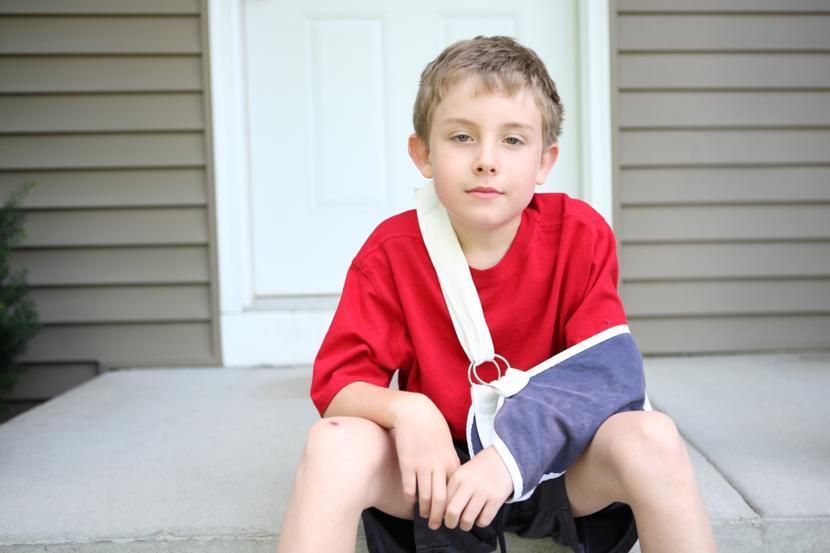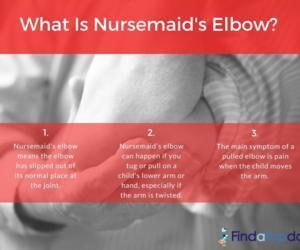Nursemaid's Elbow Treatments

What is a nursemaid's elbow?
A nursemaid's elbow is a common elbow injury among toddlers and preschoolers. This painful injury happens when a ligament slips out of its normal place in the joint. Sometimes, it resolves on its own. However, most of the time, healthcare providers help return the ligament back where it belongs by using a quick but gentle motion in the child's arm. Although children may experience elbow and arm pain when they get injured, such injury does not cause any long-lasting damage.
When your child’s arm is injured, he or she may not want to use his or her arm because of the pain. Your child may also experience severe pain along with a bad bruise an elbow fracture. For this reason, it is very important to consult a doctor since it can be difficult to tell whether your child’s injury is a fracture or a nursemaid’s elbow. A nursemaid's elbow may be painful but may not have any signs of deformities or swelling, which makes your child’s injury less noticeable.
Causes
A nursemaid's elbow commonly happens to children ages 1-4 years old. The condition is also called pulled elbow, wherein the ligaments (flexible connective tissues that connect two bones together) become loose. A nursemaid's elbow can happen even with just a little amount of force, such as:
- Swinging your child by the hands or arms
- Hyperextended elbow
- Quickly grabbing your child's hand
- Pulling your child by the wrists or hands
- Other common childhood injuries, such as rolling off beds or couches, or falling out of high chairs
Most children do not get nursemaid's elbow when they reach 5 years old and beyond. However, a nursemaid's elbow can still happen to children up to 6 to 7 years old.
Treatment
The treatment for nursemaid's elbow usually depends on the child’s age and health status. The doctor usually conducts a physical examination to make sure that the child has no broken bones. An imaging test, such as an X-ray is often unnecessary when it comes to diagnosing this condition.
For pain relief, children can be given over-the-counter pain medications, such as ibuprofen or acetaminophen. However, aspirin should never be given to children below 12 years old. Ensure to ask the doctor for your child’s correct dosage.
To return the elbow back to its normal place, healthcare providers usually perform a method called a “reduction” or “reduction maneuver”. This method usually just takes a few seconds to accomplish and is often done in the doctor’s office. To do a reduction, your healthcare provider holds your child’s wrist and elbow, and then specifically moves your child’s arm until the elbow goes back into place. When this happens, you may hear a “click” sound.
Your child may feel surprised and may probably cry after the procedure. However, most children will notice a sense of relief within 10-15 minutes after the procedure. There also children who are still reluctant to use their arm due to their fear of pain. In such cases, the doctor may prescribe a pain reliever along with an hour observation to ensure the normal mobility of the child’s arm.
An X-ray can be ordered if your child still has a difficulty moving his or her arm after the reduction maneuver. Children with a nursemaid's elbow usually have a normal X-ray result. Thus, such imaging test is not usually carried out. There are also cases, wherein the first reduction maneuver did not work. The doctor may perform another reduction to put the child’s elbow back into its correct place. A nursemaid's elbow does not usually need surgery for its treatment.
Doctors may occasionally recommend a sling for around 2-3 days to make the child feel more comfortable, particularly after successfully treating the injury through the reduction method. If the child's injury happened a few days earlier, a cast or hard splint may be utilized up to two weeks to protect the joints.
Sometimes, a nursemaid's elbow may indicate child abuse. If there are other signs of physical abuse, a legal investigation may be done.
Follow-up
A follow-up should be done within 24-48 hours if the attempts of the initial reduction are unsuccessful and if there is a need for a splint. A reevaluation is in order if the child is still unable to use the affected arm, if there is bruising or deformity, or if the findings are unexpected or unusual.
The doctor may put the arm in a cast if your child experiences such condition time and again. This is to prevent mobilization of the arm. To tighten the annular ligament, discuss with the doctor about surgery. The elbow is examined by the healthcare provider, and if needed, an X-ray will be taken.
Post-Injury Care at Home
The parent should observe the movement of the child's dislocated arm. Gradually, the child should be able to move his or her arm. To counter the pain, acetaminophen or ibuprofen will be prescribed. If trauma still persists despite home care, there are chances that your child's condition might be more than just a dislocation. Without any further delay, seek medical attention for your child. It is important to note that your child's elbow would be more difficult to relocate if it is kept dislocated for a longer time. The recovery of your child may also take a long time if the injury is not promptly treated.
Prevention
As children grow, their ligaments also get stronger. Thus, older children would become less prone to experiencing a nursemaid's elbow when their arms are pulled. The following precautions are useful when it comes to preventing a nursemaid's elbow:
- Avoid lifting your child by their hands or arms.
- Always lift your child under his or her arms.
- Avoid sudden pulling or jerking your child's wrist, arm, or hands.
- Do not swing your child by the wrists, arms, or hands.
Although there are no long-term problems associated with the condition, children who have a history of a nursemaid's elbow are more susceptible to getting the condition again later in life.














